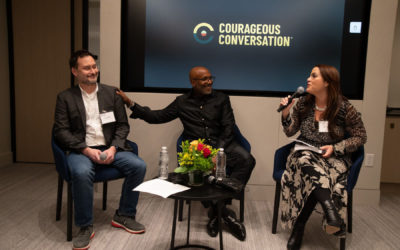By Robin diAngelo—Jan. 16 2018
I am white. As an academic, consultant and writer on white racial identity and race relations, I speak daily with other white people about the meaning of race in our lives. These conversations are critical because, by virtually every measure, racial inequality persists, and institutions continue to be overwhelmingly controlled by white people. While most of us see ourselves as “not racist”, we continue to reproduce racist outcomes and live segregated lives.
In the racial equity workshops I lead for American companies, I give participants one minute, uninterrupted, to answer the question: “How has your life been shaped by your race?” This is rarely a difficult question for people of color, but most white participants are unable to answer. I watch as they flail, some giving up altogether and waiting out the time, unable to sustain 60 seconds of this kind of reflection. This inability is not benign, and it certainly is not innocent. Suggesting that whiteness has no meaning creates an alienating – even hostile – climate for people of color working and living in predominantly white environments, and it does so in several ways.
If I cannot tell you what it means to be white, I cannot understand what it means not to be white. I will be unable to bear witness to, much less affirm, an alternate racial experience. I will lack the critical thinking and skills to navigate racial tensions in constructive ways. This creates a culture in which white people assume that niceness is the answer to racial inequality and people of color are required to maintain white comfort in order to survive.
An inability to grapple with racial dynamics with any nuance or complexity is ubiquitous in younger white people who have been raised according to an ideology of colorblindness. I have been working with large tech companies whose average employees are under 30 years old. White employees are typically dumbfounded when their colleagues of color testify powerfully in these sessions to the daily slights and indignities they endure and the isolation they feel in overwhelmingly white workplaces. This pain is especially acute for African Americans, who tend to be the least represented.
While the thin veneer of a post-racial society that descended during the Obama years has been ripped away by our current political reality, most white people continue to conceptualize racism as isolated and individual acts of intentional meanness. This definition is convenient and comforting, in that it exempts so many white people from the system of white supremacy we live in and are shaped by. It is at the root of the most common kind of white defensiveness. If racists are intentionally and openly mean, then it follows that nice people cannot be racist. How often will a white person accused of racism gather as evidence to the contrary friends and colleagues to testify to their niceness; the charge cannot be true, the friend cannot be racist, because “he’s a really nice guy” or “she volunteers on the board of a non-profit serving under-privileged youth”. Not meaning to be racist also allows for absolution. If they didn’t mean it, it cannot and should not count.
Thus, it becomes essential for white people to quickly and eagerly telegraph their niceness to people of color. Niceness in these instances is conveyed through tone of voice (light), eye contact accompanied by smiling and the conjuring of affinities (shared enjoyment of a music genre, compliments on hair or style, statements about having traveled to the country the “other” is perceived to have come from or knowing people from the other’s community). Kindness is compassionate and often implicates actions to support or intervene. For example, I am having car trouble and you stop and see if you can help. I appear upset after a work meeting and you check in and listen with the intent of supporting me. Niceness, by contrast, is fleeting, hollow and performative.
In addition to niceness, proximity is seen as evidence of a lack of racism. Consider the claims many white people give to establish that they aren’t racist: “I work in a diverse environment.” “I know and/or love people of color.” “I was in the Peace Corps.” “I live in a large urban city.” These are significant because they reveal what we think it means to be racist. If I can tolerate (and especially if I enjoy and value) proximity, claims of proximity maintain, I must not be racist; a “real” racist cannot stand to be near people of color, let alone smile or otherwise convey friendliness.
In a 1986 article about black students and school success, Signithia Fordham and John Ogbu describe a “fictive kinship” between African Americans, a kinship that is not consanguineal (by blood) or affinal but derived from the assumption of shared experience. The racial kinship white people attempt to draw from niceness might be seen as a false or fabricated affinity. Most white people live segregated lives and in fact have no lasting cross-racial relationships. We are in the position to choose segregation and often do. The claims of non-racism that we make are therefore based on the most superficial of shared experiences: passing people of color on the street of large cities and going to lunch on occasion with a co-worker.
Note that our cursory friendliness does not come without strings. Consider the case of a white California woman who called the police this past May when a group of black Airbnb guests did not return her smile. The expectation is that the “nod of approval”, the white smile, will be reciprocated. This woman, like all the other white people who have called the police on people of color for non-existent offenses, vigorously denied she was racist. After all, she did smile and wave before reporting them.
Read more at the Guardian.




